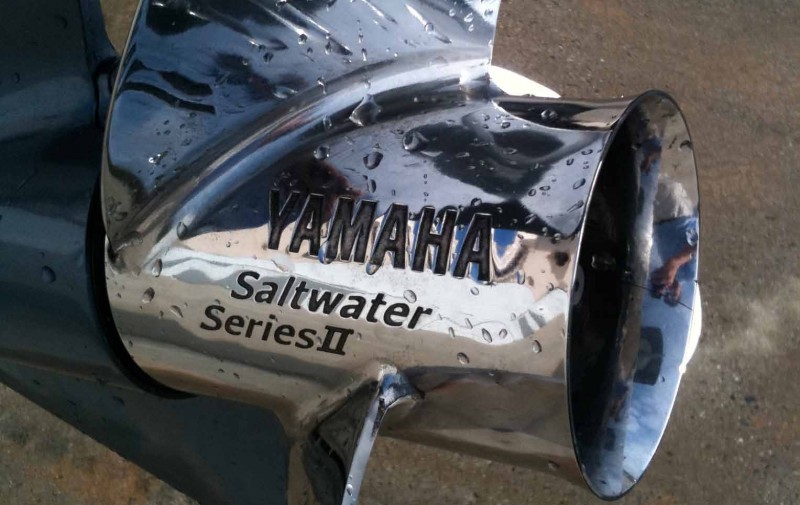
Do you think that you work hard? Try being a propeller for a day, swirling in circles for hours on end in nasty, weed-infested water, plowing blindly through mud and muck, grinding away over gravel, then whacking the occasional rock or deadhead – now that’s hard work.
To add insult to injury, if the prop gets damaged, the boat’s performance suffers, and the captain fires off a volley of expletives at the propeller. Your boat’s prop leads a tough life
Look at Me
Before every outing, we emphatically advocate that you thoroughly inspect your propeller. Look for obvious damage, particularly on the blade tips and leading edges. Nicks, dents, and dings are signs that the propeller hit something, possibly bending or cracking the blade. Remove the beat-up wheel, and install a known good prop to use while you have the sick propeller examined or repaired by a professional.

Make sure to carefully inspect your boat's propeller before each outing to determine if there is any damage that needs to be repaired
Check the prop nut to ensure that it’s tight to the engine manufacturer’s specs (and the cotter pin is secure). Prop nuts can loosen up during the course of a season; the last thing you need is for the propeller to zing off into the briny deep when you’re miles offshore.
Periodic Propeller Maintenance
The engine’s owner’s manual is the definitive source for scheduled propeller maintenance (usually 50-100 hours +/-), but we recommend that at least two or three times during the boating season, completely remove the propeller from the engine to get rid of any stray fishing line that may have wrapped itself around the propshaft.
Once the fishing line is gone, wipe off all the grease on the propeller shaft, and the seal that surrounds the propshaft at the rear of the gearcase. Carefully examine the seal for any scoring or wear. Fishing line is notoriously abrasive, and if it damages the propshaft seal, water can enter the gearcase, causing wailing and gnashing of teeth (gearcases are very expensive to repair). If fishing line is found and damage to the prop shaft seal is suspected, a quick and easy method of checking the prop seal is to drain a small amount of lower unit lube into a clean pan or jar. If the lubricant is milky, water has entered the lower unit. If this is the case, or if the propeller shaft seal is questionable for any reason, have the lower unit looked at by a certified technician before using it again – just in case. Barring any fishing line/propshaft seal issues, liberally coat the propeller shaft with Yamalube® Marine Grease (by hand) to rub the grease onto the entire shaft’s surface. Then, reinstall the propeller; tighten the prop nut to spec, and place a new stainless steel cotter pin through the prop nut and propshaft to keep the propeller where it belongs.

Great propeller service teams are proficient in welding, grinding and re-structuring propellers to their original condition.
Miscellaneous Propeller Maintenance
Depending on how you treat your propeller, the paint on an aluminum propeller may wear off. If the propeller is in good shape, you can take off wheel, and repaint it with the original color paint – or any color you like – it’s your boat, after all.
Boating in brackish, polluted, or saltwater can cause polished stainless propellers to lose their luster over time. Try using a bathroom cleaner (the kind for soap scum) to scrub residue off of the prop; believe it or not, it usually does a pretty good job.
Speaking of stainless wheels, they’re not stain-proof – they’re stain-less. If you boat in salty, polluted or icky contaminated water, rinse the propeller with fresh water after you’re done for the day, to stave off the development of red iron oxide and prevent the accumulation of an unidentifiable non-aesthetic film from forming on the prop.
If conditions warrant, you might consider “000” steel wool, penetrating oil, and plenty of elbow grease to eradicate any rust that may appear on your stainless steel propeller.
Can It Be Fixed?

Fishing line is extremely abrasive and if it damages the propshaft seal, water can enter the gearcase and cause even more damage.
Unless you’ve wadded up your propeller like a tinfoil sandwich wrapper, or broken a blade off at the hub, chances are that the prop can be restored. Propeller repair results from a fine combination of a deep understanding of hydrodynamics in the context of the propeller/engine/boat relationship, advanced proficiency in metallurgy, as well as highly developed skills in welding, grinding, and reconstructing the propeller to the original manufacturer’s specifications.
Dents straighten out, cracks vanish, and divots disappear in the hands of a skilled prop crew. Some propeller repair work in progress can resemble an old-time blacksmith’s shop – sparks flying, grinding, welding, and the pounding of hammers. To help ensure the reconditioned propeller’s blades are the same shape as they were when new, the craftsmen in the prop shop often use steel pitch blocks – basically, anvils precisely machined to the identical contour and blade geometry of almost every propeller made. After the major repairs are done, the prop is balanced, and painted, buffed, or polished – depending on the final finish desired by the propeller’s owner
Share the Care
Your propeller is really low-maintenance, when compared to the rest of your boat; however, the prop does need a little attention now and again to keep doing its job well. Consider this – without a propeller, your motorboat is nothing but a very nice raft.
Resources
Yamaha Motor Corporation, USA www.yamaha-outboards.com
National Marine Propeller Association www.nmpa.net
Photo Credits Bob Mussleman, Admiral C&B Propeller
 Your Privacy Choices
Your Privacy Choices
 The
The